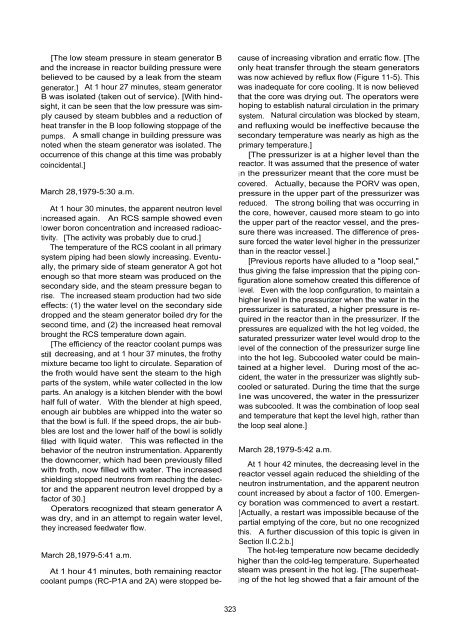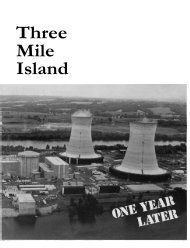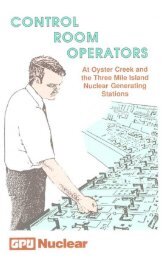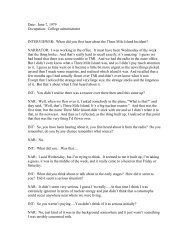- Page 2: COVER:A heat-sensitive DOE photogra
- Page 5 and 6: 15. Public Announcements16. Board N
- Page 7 and 8: 4. Estimates of Doses and Potential
- Page 9 and 10: 7. Effects on Aquatic Biota and Fis
- Page 11 and 12: IV.Safety Management Factors German
- Page 13 and 14: A SEQUENCE OFPHYSICAL EVENTSThe fol
- Page 15 and 16: polisher system are discussed in Se
- Page 17 and 18: FIGURE 11-3. The Makeup and Letdown
- Page 19 and 20: pumps 6 into the RCS. At TMI-2, the
- Page 21 and 22: FIGURE II-5. The Once-Through Steam
- Page 23 and 24: March 28,1979-4:30 a.m.At approxima
- Page 25: still having trouble stabilizing th
- Page 29 and 30: [Leakage through the PORV had now b
- Page 31 and 32: shut. Closing this valve, with pump
- Page 33 and 34: Each of the two core flood tanks ho
- Page 35 and 36: March 28,1979-3:10 p.m.At 11 hours
- Page 37 and 38: FIGURE 11-8. Gas Venting SystemGase
- Page 39 and 40: perature in the loop A cold leg was
- Page 41 and 42: Up to this time, degassing of the R
- Page 43 and 44: oxygen in the presence of radiation
- Page 45 and 46: B RADIOLOGICALRELEASES AND THEIREFF
- Page 47 and 48: either trapped or chemically bound.
- Page 49 and 50: FIGURE 11-9. Ventilation and Waste
- Page 51 and 52: a representative sample of carbon r
- Page 53 and 54: FIGURE II-10. Liquid Radioactive Wa
- Page 55 and 56: cess radioactive material. The IWTS
- Page 57 and 58: FIGURE 11-12. Release PathwaysConti
- Page 59 and 60: tective efforts did not provide any
- Page 61 and 62: TABLE 11-3. 1-131 releases-Continue
- Page 63 and 64: TABLE 11-4. Calculated 1311 release
- Page 65 and 66: The cleanup components installed in
- Page 67 and 68: was made prior to the large influx
- Page 69 and 70: TABLE 11-7. Analysis of TMI-2 conta
- Page 71 and 72: TABLE 11-9. Inventories of radioact
- Page 73 and 74: a. Offsite Radiological Environment
- Page 75 and 76: COLOR PLATE I. LOCATION OF OOSIMETR
- Page 77 and 78:
These samples were later counted wi
- Page 79 and 80:
TABLE 11-12. NRC TLD locations-Cont
- Page 81 and 82:
TABLE II-13. Raw milk sample progra
- Page 83 and 84:
TABLE 11-14. Source locations for H
- Page 85 and 86:
TABLE 11-14. Source locations for H
- Page 87 and 88:
TABLE 11-14. Source locations for H
- Page 89 and 90:
TABLE 11-16. EPA milk sampling loca
- Page 91 and 92:
0331 3:28 a.m. GE-4; Fence, east Gr
- Page 93 and 94:
0331 9:03 p.m. '/4 east ofObservati
- Page 95 and 96:
April 6, 1979-By April 6, offsite e
- Page 97 and 98:
TABLE 11-20. Met Ed Teledyne and RM
- Page 99 and 100:
TABLE 11-21. Net exposures, attribu
- Page 101 and 102:
Table 11-22 contains daily data fro
- Page 103 and 104:
SW-1 0.9±0.1 0.8 1.2 ±0.3 1.1 ±0
- Page 105 and 106:
Other Collective Dose Estimate-Usin
- Page 107 and 108:
not have any discernible effect. Th
- Page 109 and 110:
em and dose rates on the order of r
- Page 111 and 112:
dose will, according to BEIR III es
- Page 113 and 114:
cancer, which corresponds to 175.8
- Page 115 and 116:
The technical specifications for TM
- Page 117 and 118:
that facility did not provide suffi
- Page 119 and 120:
FIGURE 11-17. Actual Organization o
- Page 121 and 122:
FIGURE II-18. "Normal" Emergency Or
- Page 123 and 124:
monitoring activities and Dubiel wo
- Page 125 and 126:
FIGURE 11-21. Emergency Radiation P
- Page 127 and 128:
clothing was exchanged for paper co
- Page 129 and 130:
As part of the training conducted b
- Page 131 and 132:
equipped with Geiger-Muller (G-M) t
- Page 133 and 134:
TABLE 11-37. Atmospheric monitoring
- Page 135 and 136:
SAM-2 in another kit was issued eve
- Page 137 and 138:
Preaccident Personnel Dosimetry-The
- Page 139 and 140:
ecommendations for correcting them.
- Page 141 and 142:
nel, reflect the continued inadequa
- Page 143 and 144:
that have evolved comprehensively a
- Page 145 and 146:
REFERENCES AND NOTES1 Met Ed, "Fina
- Page 147 and 148:
term Environmental Radiation Monito
- Page 149 and 150:
United Nations Scientific Committee
- Page 151 and 152:
302NRC, "Investigation into the Mar
- Page 153 and 154:
the emergency feedwater system, amo
- Page 155 and 156:
FIGURE 11-22. Pressurizer Surge Lin
- Page 157 and 158:
k)ss of heat removal from the prima
- Page 159 and 160:
main feedwater pumps and turbine ar
- Page 161 and 162:
Recommendations-The categorization
- Page 163 and 164:
through the break will not result i
- Page 165 and 166:
Findings-Under normal circumstances
- Page 167 and 168:
psig, 66although some reactor build
- Page 169 and 170:
A thorough evaluation should be per
- Page 171 and 172:
Shortly after their start the diese
- Page 173 and 174:
thereby providing high level coolin
- Page 175 and 176:
the service-instrument air cross-se
- Page 177 and 178:
Following recovery of hotwell level
- Page 179 and 180:
TABLE 11-44. Accident monitoring in
- Page 181 and 182:
TABLE 11-47. Information readouts a
- Page 183 and 184:
TABLE 11-47. Information readouts a
- Page 185 and 186:
2TABLE 11-47. Information readouts
- Page 187 and 188:
TABLE 11-49. Errors at most recent
- Page 189 and 190:
TABLE 11-51. Estimated data reliabi
- Page 191 and 192:
expected to survive environments mo
- Page 193 and 194:
TABLE 11-52. Sources of data about
- Page 195 and 196:
FIGURE 11-23. TMI-2 Isometric Schem
- Page 197 and 198:
FIGURE 11-25. The Pressurizer492
- Page 199 and 200:
COLOR PLATE IV. HOT AND COLD LEG TE
- Page 201 and 202:
egan to heat up. When the hottest p
- Page 203 and 204:
FIGURE 11-26. System Parameters for
- Page 205 and 206:
Steaming to Condenser.SRM-count rat
- Page 207 and 208:
emained open for more than 1 1 /2 h
- Page 209 and 210:
FIGURE II 2'1. Hydrogen Burn at 9.9
- Page 211 and 212:
PZR Vent and Spray Valves-closed.De
- Page 213 and 214:
1 2 3 4 5 6 7 8 9 10 11 12 13 14 15
- Page 215 and 216:
of time, to determine a heat balanc
- Page 217 and 218:
locked to steam flow by hydrogen th
- Page 219 and 220:
two-phase mixture of water and stea
- Page 221 and 222:
e made for two reasons: (1) the act
- Page 223 and 224:
FIGURE 11-31. Fuel Temperature Hist
- Page 225 and 226:
Additionally, it is estimated that
- Page 227 and 228:
15 minutes (3 hours 21 minutes to 3
- Page 229 and 230:
system if all of the water removed
- Page 231 and 232:
FIGURE 11-32. Reactor Primary Syste
- Page 233 and 234:
eleased before melting. In general,
- Page 235 and 236:
the decay calculation. Table 11-57
- Page 237 and 238:
RadiolysisRadiation absorbed in wat
- Page 239 and 240:
principle-the compliance of a liqui
- Page 241 and 242:
Error AnalysisAn error analysis of
- Page 243 and 244:
Explosive Hazard in Reactor VesselA
- Page 245 and 246:
gression was such that a substantia
- Page 247 and 248:
TABLE 11-58. Timing of a meltdown a
- Page 249 and 250:
vessel steel are matters of conside
- Page 251 and 252:
Reactor Building Base Mat Penetrati
- Page 253 and 254:
1 Met Ed, "Final Safety Analysis Re
- Page 255 and 256:
Injection Signal Reset Following a
- Page 257 and 258:
175Id. at 18-21.176Electrical Power
- Page 259 and 260:
D ALTERNATIVEACCIDENT SEQUENCESIn t
- Page 261:
• failure of operators to recogni
- Page 264 and 265:
Two variations in the flow rates fr
- Page 266 and 267:
gression than alternative sequences
- Page 268 and 269:
TABLE 11-59. Description of alterna
- Page 270 and 271:
FIGURE II-39. Comparison of Base Ca
- Page 272 and 273:
lack of emergency feedwater after a
- Page 274 and 275:
FIGURE 11-42. Effect of Pump Trips
- Page 276 and 277:
egions occurring as the reactor coo
- Page 278 and 279:
TABLE 11-61. Typical containment de
- Page 280 and 281:
E HUMAN FACTORS1. INTRODUCTIONFrom
- Page 282 and 283:
FIGURE 11-44. PORV Indicator Light
- Page 284 and 285:
cable to this written procedure and
- Page 286 and 287:
FIGURE 11-46. EFW Control Station S
- Page 288 and 289:
accident; and (2) these errors resu
- Page 290:
guidance on the use of some very im
- Page 293 and 294:
TABLE 11-62. TMI-2 control room key
- Page 295 and 296:
FIGURE 11-49. Visual Scan Necessary
- Page 297 and 298:
FIGURE 11-51. Relationship of Makeu
- Page 299 and 300:
FIGURE 11-53. Typical TMI-2 Alarm P
- Page 301 and 302:
than the other two, having only one
- Page 303 and 304:
• too many exceptions to the go-n
- Page 305 and 306:
tion or production facility," which
- Page 307 and 308:
5. classroom training course on TMI
- Page 309 and 310:
applicants for CRO licenses for nuc
- Page 311 and 312:
6. It took an archaic approach to l
- Page 313 and 314:
may be compared to nuclear powerpla
- Page 315 and 316:
evaluating the need for operator tr
- Page 317 and 318:
• misleading labeling due to viol
- Page 319 and 320:
encourage an increased rate of inco
- Page 321 and 322:
REFERENCES AND NOTES1 NRC, Investig
- Page 323 and 324:
' * Letter from Miller, Met Ed, to
- Page 325 and 326:
F ENVIRONMENTAL ANDSOCIOECONOMICIMP
- Page 327 and 328:
FIGURE 11-55. Map of Area621
- Page 329 and 330:
FIGURE 11-58. Initial Sources of In
- Page 331 and 332:
FIGURE 11-59. Percent of Persons Sa
- Page 333 and 334:
FIGURE 11-62. Percent of Individual
- Page 335 and 336:
FIGURE 11-64. Respondents' Reasons
- Page 337 and 338:
FIGURE 11-66. Respondents' Evaluati
- Page 339 and 340:
considered changing jobs more frequ
- Page 341 and 342:
FIGURE 11-70. Respondent's Concern
- Page 343 and 344:
FIGURE II-71. Costs Per Evacuating
- Page 345 and 346:
three-tenths of 1% of annual person
- Page 347 and 348:
posed by the municipality and appro
- Page 349 and 350:
achieved with volunteer labor, addi
- Page 351 and 352:
eady done so. Within 15 miles, an e
- Page 353 and 354:
APPENDIX 11.1I NTRODUCTION TOSEQUEN
- Page 355 and 356:
EventNumberDateTimeafterinitiationE
- Page 357 and 358:
EventNumberDateTimeafterinitiationE
- Page 359 and 360:
EventNumberDateTimeafterinitiationE
- Page 361 and 362:
EventNumberDateTimeafterinitiationE
- Page 363 and 364:
EventNumberDateTimeafterinitiationE
- Page 365 and 366:
EventNumberDateTimeafterinitiationE
- Page 367 and 368:
EventNumberDateTimeafterinitiationE
- Page 369 and 370:
EventNumberDateTimeafterinitiationE
- Page 371 and 372:
EventNumberDateTimeafterinitiationE
- Page 373 and 374:
EventNumberDateTimeafterinitiationE
- Page 375 and 376:
EventNumberDateTimeafterinitiationE
- Page 377 and 378:
EventNumberDateTimeafterinitiationE
- Page 379 and 380:
EventNumberDateTimeafterinitiationI
- Page 381 and 382:
EventNumberDateTimeafterinitiationE
- Page 383 and 384:
EventNumberDateTimeafterinitiationE
- Page 385 and 386:
EventNumberDateTimeafterinitiationE
- Page 387 and 388:
EventNumberDateTimeafterinitiationE
- Page 389 and 390:
EventNumberDateTimeafterinitiationE
- Page 391 and 392:
EventNumberDateTimeafterinitiationE
- Page 393 and 394:
EventNumberDateTimeafterinitiationE
- Page 395 and 396:
EventNumberDateTimeafterinitiationE
- Page 397 and 398:
EventNumberDateTimeafterinitiationE
- Page 399 and 400:
EventNumberDateTimeafterinitiationE
- Page 401 and 402:
EventNumberDateTimeafterinitiationE
- Page 403 and 404:
EventNumberDateTimeafterinitiationI
- Page 405 and 406:
EventNumberDateTimeafterinitiationE
- Page 407 and 408:
EventNumberDateTimeafterinitiationE
- Page 409 and 410:
EventNumberDateTimeafterinitiationE
- Page 411 and 412:
APPENDIX 11.2CARBON PERFORMANCEWITH
- Page 413 and 414:
presented in App. Table 11-2. The g
- Page 415 and 416:
APP. TABLE 11-4. Physical propertie
- Page 417 and 418:
APPENDIX 11.3RADIOLOGICAL ENVIRONME
- Page 419 and 420:
Sampling locations are shown in Fig
- Page 421 and 422:
APPENDIX 11.4OFFSITE RADIOLOGICALMO
- Page 423 and 424:
APP. TABLE 11-7. Field Ge(Li) and H
- Page 425 and 426:
APP. FIGURE 11-2. EML Measurement S
- Page 427 and 428:
APPENDIX 11.5ATMOSPHERIC RELEASE AD
- Page 429 and 430:
they did not have enough familiarit
- Page 431 and 432:
APPENDIX 11.6RADIOLOGICAL CHRONOLOG
- Page 433 and 434:
ITEM DATE AND TIME EVENT DESCRIPTIO
- Page 435 and 436:
ITEM DATE AND TIME EVENT DESCRIPTIO
- Page 437 and 438:
ITEM DATE AND TIME EVENT DESCRIPTIO
- Page 439 and 440:
ITEM DATE AND TIME EVENT DESCRIPTIO
- Page 441 and 442:
REFERENCES AND NOTES1 NRC, "Investi
- Page 443 and 444:
The apparent surface area isFor Apr
- Page 445 and 446:
APPENDIX 11.8TMIBOIL CODE CALCULATI
- Page 447 and 448:
APP. TABLE 11-8.TMIBOIL calculation
- Page 449 and 450:
APP. FIGURE II-3. Fuel Temperature
- Page 451 and 452:
APP. FIGURE 11-7. Fuel Temperature
- Page 453 and 454:
APP. FIGURE II-11. Fuel Temperature
- Page 455 and 456:
APP. FIGURE 11-15. Fuel Temperature
- Page 457 and 458:
APP. FIGURE 11-19. Fuel Temperature
- Page 459 and 460:
Memorandum from G. P. Marino and J.
- Page 461 and 462:
This equation (which contains no ap
- Page 463 and 464:
We have not included the effects of
- Page 465 and 466:
APP. FIGURE 11-22. Bubble Volume at
- Page 467 and 468:
a) The fugacity coefficient of hydr
- Page 469 and 470:
TABLE 1. Hydrogen solubility dataTe
- Page 471 and 472:
APP. FIGURE 11-24. Hydrogen Solubil
- Page 473 and 474:
APP. FIGURE 11-26. B&W Test #5-Prop
- Page 475 and 476:
APP. FIGURE 11-28. B&W Test #7-Prop
- Page 477 and 478:
APP. FIGURE 11-30. Reactor Coolant
- Page 479 and 480:
2. EXCERPTS FROM TMI-2 SENSITIVITYS
- Page 481 and 482:
APP. FIGURE 11-32. Relative SRM Res
- Page 483 and 484:
tegration over time dependent varia
- Page 485 and 486:
A99 FIGURE D-33 Plots of Input Data
- Page 487 and 488:
APP. FIGURE 11-35. Postulated Core
- Page 489 and 490:
APP. FIGURE 11-37. Postulated Core
- Page 491 and 492:
APP. FIGURE 11-39.SRM Reading Versu
- Page 493 and 494:
4. ALTERNATE INTERPRETATION OFTHE A
- Page 495 and 496:
etween about 740 and 775 minutes (1
- Page 497 and 498:
APP. FIGURE II-43. Hydrogen Pressur
- Page 499 and 500:
APP. FIGURE 11-45. Hydrogen Pressur
- Page 501 and 502:
APP. FIGURE II-47. Water Flow Rates
- Page 503 and 504:
APP. FIGURE 11-49. Water Height in
- Page 505 and 506:
APP. FIGURE 11-51. Temperature Leve
- Page 507 and 508:
ing fuel (G. W. Parker et al. ORNL-













